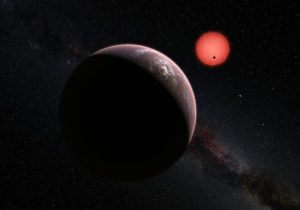 Thanks to new research done on the seven Earth-sized planets within the TRAPPIST-1 star system, the possibility of life on other planets seems greater than ever. Provided it can cope with a lot of water, that is.
Thanks to new research done on the seven Earth-sized planets within the TRAPPIST-1 star system, the possibility of life on other planets seems greater than ever. Provided it can cope with a lot of water, that is.
Science News reports on observations made regarding the seven roughly Earth-sized planets orbiting the star TRAPPIST-1 and the case for the development of life on any one of them. What we’ve found so far is that these planets have large amounts of water.
Just how much water, however, is rather surprising. Two of the planets, TRAPPIST-1f and TRAPPIST-1g, are both estimated to be composed of roughly 50% water (for reference, Earth is only about 0.1% water). This is startling to think of, as this much water could easily be a breading ground for extraterrestrial life.
This discovery was made by Arizona State University exogeologist Cayman Unterborn. Using previously calculated measurements for the planets’ size, the research team went about calculating the approximate densities of the different TRAPPIST-1 planets. Using the information available, they discovered that, unlike one would expect, some of the planets turned out to be much less dense than one would expect.
As a result, the only conclusion the team could come to was that these planets contained large amounts of water. The planets are not the right size to hold dense atmospheres of gas, meaning something else must be present to account for the density values. Both liquid water and solid ice are much less dense than rock, accounting for the difference between the expected density of an Earth-like planet and the actual calculated density of the two TRAPPIST-1 planets from before. And with water may come life.
There is an issue with detecting any life that forms on the planet, though. Because there is so much water, there is likely many new interactions between it and the planet that we have not observed on Earth. As an example, large portions of these planets’ water may be solid ice, formed from the massive amounts of pressure exerted on the water by itself.
As a result of this, it could be difficult to tell the difference between the initial state of life on these planets and regular geochemical processes found on most any Earth-like planet. If life does begin on these planets, however, Unterborn’s team will be hard at work to find it no matter what problems the planets present them.











